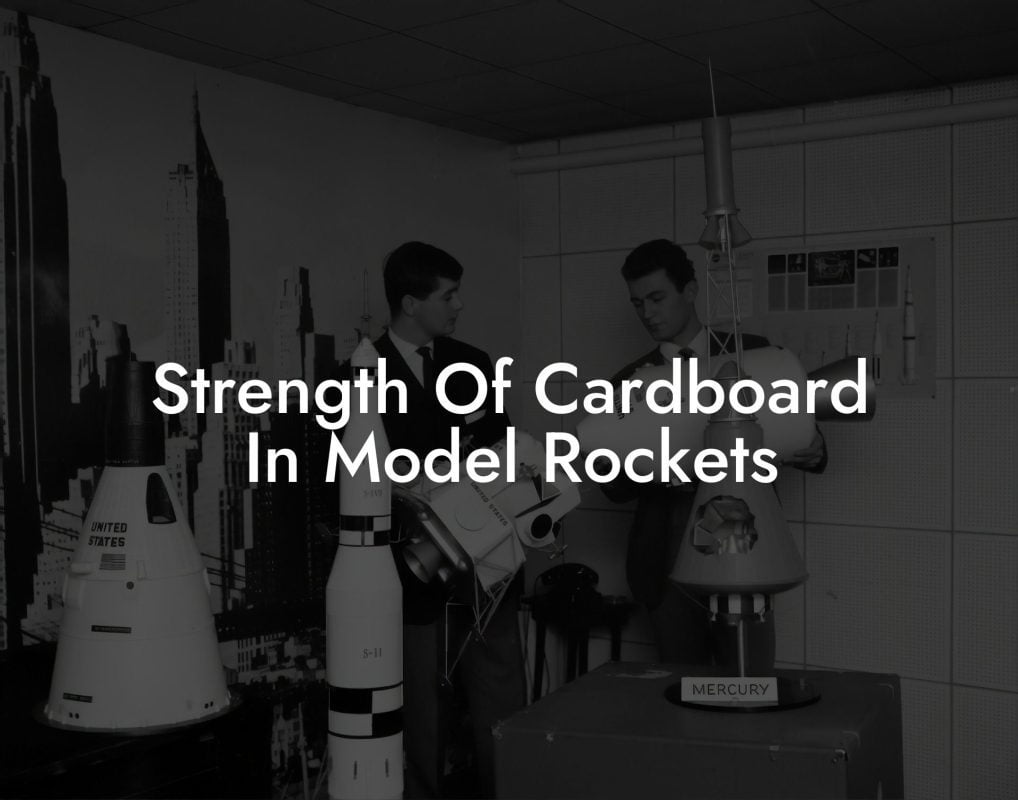Imagine the rush of launching your own Level 2 model rocket into the sky, feeling the thrill of watching it soar to incredible heights, and experiencing the satisfaction of a successful recovery. Welcome to the world of advanced model rocketry, where the boundaries of aerodynamics and innovation are pushed to new limits.
Quick Links to Useful Sections
What Are Level 2 Model Rockets?
Level 2 model rockets represent a significant step up from beginner-friendly Level 1 models. These advanced rockets are designed for experienced enthusiasts who crave more power, complexity, and customization. With Level 2 rockets, you'll encounter larger motors, more sophisticated electronics, and intricate construction techniques that demand precision and skill.
In simple terms, Level 2 model rockets are the perfect choice for those who have mastered the basics and are ready to take their hobby to the next level. Whether you're seeking to break altitude records, experiment with new designs, or simply enjoy the thrill of flying a high-performance rocket, Level 2 models offer an unparalleled experience.
Key Features of Level 2 Model Rockets
So, what sets Level 2 model rockets apart from their Level 1 counterparts? Here are some key features that define these advanced rockets:
- Larger Motors: Level 2 rockets are powered by more potent motors, such as H, I, and J motors, which deliver greater thrust and altitude capabilities.
- Advanced Electronics: These rockets often feature sophisticated electronics, including altimeters, GPS, and recovery systems, which enhance performance, safety, and recovery.
- Intricate Construction: Level 2 models require more complex construction techniques, such as fiberglassing, fin canning, and precision assembly, which demand greater skill and attention to detail.
- Customization Options: With Level 2 rockets, you have more freedom to experiment with unique designs, materials, and components, allowing you to express your creativity and push the boundaries of model rocketry.
By combining these advanced features, Level 2 model rockets offer an unparalleled level of excitement, challenge, and satisfaction for experienced enthusiasts.
Looking For The Best Model Rocket Kits? You'll Love These:
Designing and Building a Level 2 model rocket
Building a Level 2 model rocket is a significant undertaking that requires careful planning, precision craftsmanship, and attention to detail. Here are some essential steps to help you get started:
- Choose a Design: Select a proven design or create your own, taking into account factors like stability, aerodynamics, and recovery systems.
- Select Materials: Choose the right materials for your rocket, including lightweight yet durable components, such as fiberglass, carbon fiber, or advanced plastics.
- Construct the Airframe: Use precision techniques, like fin canning and body tubing, to create a strong, lightweight airframe.
- Install Electronics: Integrate advanced electronics, such as altimeters and GPS, to enhance performance and recovery.
- Motor Selection: Choose a suitable motor for your rocket, considering factors like thrust, specific impulse, and reliability.
By following these steps and dedicating time and effort to your project, you'll be able to create a Level 2 model rocket that's both visually stunning and high-performing.
Flying and Recovering a Level 2 Model Rocket
Launching and recovering a Level 2 model rocket requires careful planning, attention to detail, and a solid understanding of aerodynamics and recovery systems. Here are some essential tips to help you succeed:
- Pre-launch Checks: Conduct thorough checks on your rocket, motor, and recovery system to ensure everything is functioning correctly.
- Choose a Safe Launch Site: Select a launch site with minimal obstacles, clear visibility, and a reliable recovery area.
- Launch and Track: Launch your rocket, track its ascent and descent, and use data from your altimeter and GPS to refine your recovery strategy.
- Recovery Techniques: Employ advanced recovery techniques, such as parachute deployment and streamer recovery, to ensure a safe and successful recovery.
By following these guidelines and staying focused on safety and performance, you'll be able to enjoy the thrill of flying a Level 2 model rocket while minimizing the risk of loss or damage.
Resources and community Support: Your Next Steps
Embarking on a Level 2 model rocket project can be a challenging yet rewarding experience. To help you succeed, we've compiled a list of essential resources and community support options:
- Online Forums: Join online forums, like Reddit's r/modelrockets, to connect with experienced enthusiasts, ask questions, and share your experiences.
- Model Rocketry Clubs: Look for local model rocketry clubs or organizations, like the National Association of Rocketry, to network with fellow enthusiasts and gain access to exclusive resources.
- Tutorials and Guides: Explore online tutorials, guides, and videos that offer step-by-step instructions and expert advice on designing, building, and flying Level 2 model rockets.
- Kits and Supplies: Visit online retailers, like Apogee Components or Rocketarium, to find high-quality kits, materials, and components specifically designed for Level 2 model rockets.
By leveraging these resources and connecting with the model rocketry community, you'll be able to overcome challenges, refine your skills, and take your hobby to new heights.
Frequently Asked Questions: Level 2 Model Rockets
Here are some frequently asked questions about Level 2 model rockets, along with expert answers to help you get started:
1. What is the minimum age requirement for flying a Level 2 model rocket?
There is no specific minimum age requirement, but Level 2 rockets are generally recommended for experienced enthusiasts aged 18 and above.
2. Do I need a special license to fly a Level 2 model rocket?
In most countries, you don't need a license to fly a model rocket, but you must comply with local regulations, safety guidelines, and airspace restrictions.
3. How high can a Level 2 model rocket fly?
The altitude of a Level 2 model rocket depends on the motor, design, and weather conditions, but it can reach heights of over 5,000 feet (1,524 meters).
4. What is the average cost of a Level 2 model rocket kit?
The cost of a Level 2 model rocket kit can vary greatly, ranging from $200 to over $1,000, depending on the complexity, materials, and brand.
5. Can I customize my Level 2 model rocket with unique designs and materials?
Yes, one of the advantages of Level 2 model rockets is the freedom to experiment with custom designs, materials, and components, allowing you to express your creativity and push the boundaries of model rocketry.
Looking For The Best Model Rocket Kits? You'll Love These:
Useful Interruption: Dive deeper into the world of Model Rockets with our most popular sections. If there is anything you think is missing or anything you would love for us to write about, just give us a shout.
- Getting Started & Basics With Model Rockets
- Model Rocket Design, Build & Customization
- Model Rocket Propulsion & Engine Technology
- Model Rocket Launch Techniques & Recovery
- Model Rocket Advanced Rocketry & Innovations
- Model Rocket DIY and Customization
- Model Rocket Equipment Reviews & Digital Tools
- Community, Competitions & Education
- Model Rocket Troubleshooting & FAQs
- Model Rocket Bonus/Seasonal & Niche Topics
A group of model rocket enthusiasts gathered at a field for their weekly launch event. Among them was Dave, a seasoned builder known for pushing the limits of hobby rocketry. This time, he had outdone himself.
“Ladies and gentlemen,” Dave announced, dramatically pulling a cloth off his latest creation, “I present to you: The Kraken!”
The crowd gasped. This wasn’t just a model rocket—it was a monster. The thing stood 8 feet tall, had six clustered engines, and was covered in enough duct tape to qualify as a classified aerospace project.
“Dave,” muttered Steve, the cautious safety officer, “Have you, uh… done the math on this?”
“Math?” Dave scoffed. “I built it in my garage at 3 a.m. with parts from eBay. This is an art piece, Steve.”
The countdown began.
5…
4…
3…
2…
1…
The engines ignited with a BOOM, and The Kraken shot up… kind of. It immediately did a violent barrel roll, narrowly missing the spectators before skyrocketing at an angle that could only be described as “legally questionable.”
The crowd collectively ducked as The Kraken flew straight over the adjacent cornfield, where Old Man Jenkins, the grumpiest farmer in town, was minding his business.
KABOOM!
The rocket disappeared behind the barn. A moment later, a flaming piece of Estes igniter wire landed at Steve’s feet. The silence was deafening.
And then—an unmistakable sound echoed across the field.
Jenkins’ shotgun being cocked.
“DAVE!!!” Steve shouted. “RUN.”
And that was the day Dave invented the first-ever biologically powered rocket booster: pure adrenaline.
To this day, nobody knows where The Kraken landed, but legend has it, it still haunts the skies, terrifying unsuspecting drones and low-flying birds.















